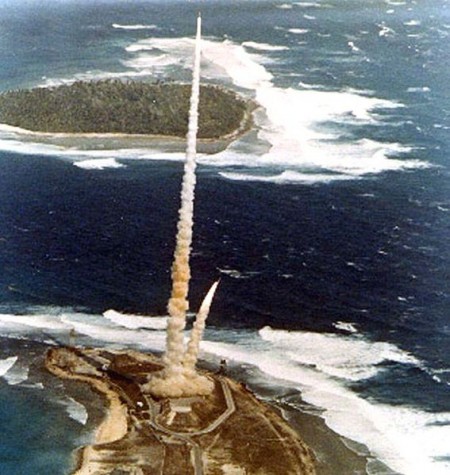Forty-two years ago this month, a pair of SPRINT ABM interceptors fired from the Kwajalein Missile Range intercepted a reentry vehicle launched from Vandenberg Air Force Base, California. It was the first salvo launch of the legendary hypersonic interceptor.
The Safeguard Anti-Ballistic Missile (ABM) System was developed between the mid-960’s and mid-1970’s to protect United States ICBM sites. Safeguard consisted of an exoatmospheric missile (Spartan) and an endoatmospheric interceptor (SPRINT). In today’s missile defense parlance, we would refer to these vehicles as mid-course and terminal phase interceptors, respectively.
The 3-stage Spartan measured 55 feet in length, weighed 28,700 pounds at launch and had a range of 465 miles. Vehicle maximum velocity was in excess of 4,000 ft/sec. Spartan was armed with a 5-megaton nuclear warhead. Target destruction was effected via neutron flux.
The Solid Propellant Rocket INTerceptor (SPRINT) missile was a 2-stage vehicle. It measured 27 feet in length, weighed 7,500 pounds at launch and had a maximum range of 25 miles. SPRINT was configured with a nuclear warhead that had a yield on the order of several kilotons. Target destruction was also via radiation kill.
SPRINT’s performance was astounding by any measure. One second after first stage rocket motor ignition, the vehicle was already a mile away from the launch site. The Mach 5 stage separation event occurred a little over 1.2 seconds from first stage ignition.
The SPRINT upper stage saw a peak acceleration of 100 g’s and reached Mach 10 in about 6 seconds. Maximum mission duration was 15 seconds.
SPRINT’s rapid velocity build-up produced a correspondingly rapid rise in the vehicle’s surface temperature due to aerodynamic heating. The second stage glowed incandescently in daylight as its surface temperature exceeded that of an acetylene torch. The severe thermal state also resulted in the shock layer flow near the missile’s surface becoming a partially-ionized plasma.
SPRINT electromechanical and electronic equipment had to be ruggedized to handle the extreme shock, vibration, and acceleration environment of flight. In addition, the vehicle was hardened to withstand the severe pressure and electromagnetic pulses associated with a thermonuclear warhead detonation.
SPRINT flight testing started at White Sands Missile Range (WSMR) in November of 1965. Devoted to SPRINT subsystem testing, the WSMR flight test campaign ended in August 1970 and consisted of 42 shots.
Overall Safeguard system testing was conducted at the Kwajalein Missile Range (KMR) beginning in 1970 and extended through 1973. The KMR flight test program consisted of 34 flight tests. The first successful SPRINT intercept of a reentry vehicle took place in December 1970.
On Wednesday, 17 March 1971, SPRINT interceptors FLA-49 and FLA-50 were launched in salvo from Meck Island located on the eastern edge of the Kwajalein Atoll. The target for this mission was a Minuteman I reentry vehicle launched 4,800 miles to the east at Vandenberg Air Force Base. The target was successfully engaged and destroyed.
In October of 1974, a single Safeguard System unit became operational at Grand Forks Air Force Base, North Dakota. Interestingly, by February 1976, this lone deployed unit would be permanently deactivated. Thus ended the Safeguard ABM Program. A combination of high costs, questionable efficacy, lack of congressional support and international politics accounted for its very brief operational life.

